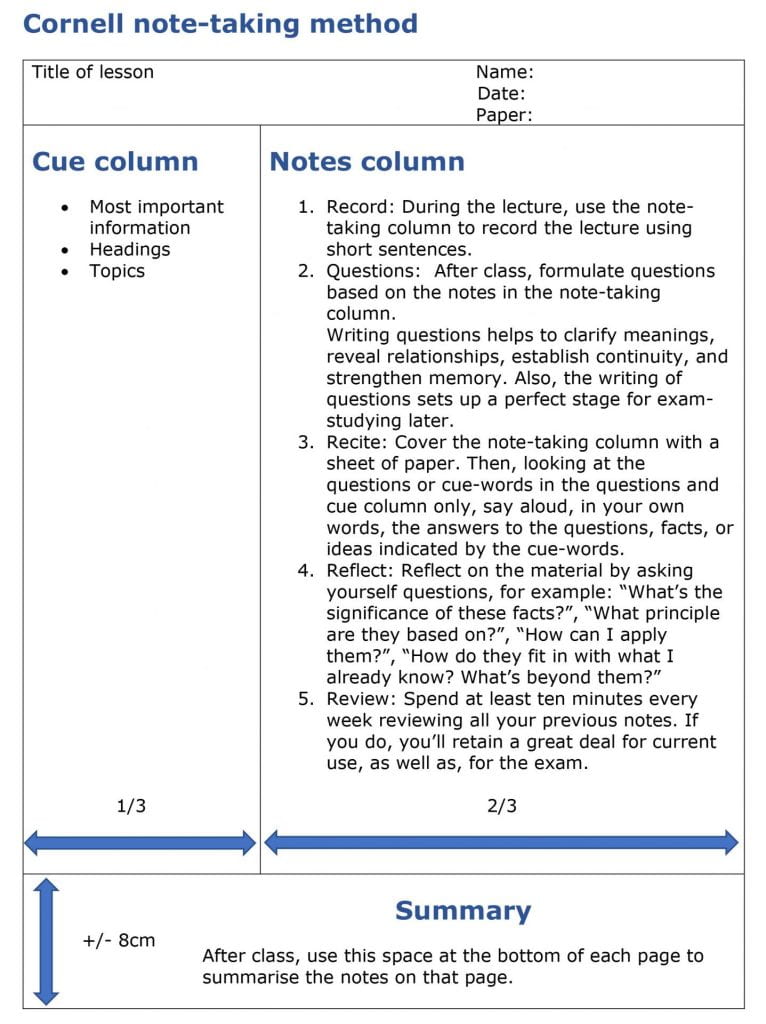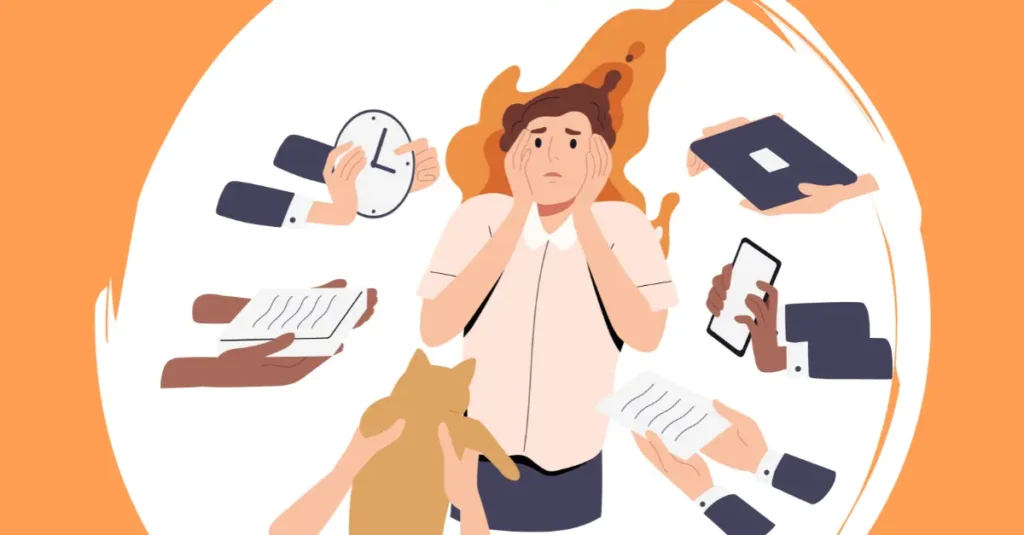Introduction
Note-making techniques are a crucial skill for students, professionals, and lifelong learners. It aids in information retention, organization, and recall. However, not all note-taking methods are equally effective. Various psychological principles, such as cognitive load theory, dual-coding theory, and active recall, contribute to optimizing note-making techniques.
Read More- Effective Studying Techniques
1. The Cornell Method
Developed by Walter Pauk at Cornell University, this method divides notes into three sections: a main notes section, a cue column for keywords and questions, and a summary section at the bottom.

Psychological Basis
The psychological basis of this technique includes-
- Active Recall: Writing down cues and summarizing key points encourages active engagement with the material, strengthening memory retrieval (Roediger & Butler, 2011).
- Spaced Repetition: Reviewing Cornell notes periodically aligns with Ebbinghaus’ Forgetting Curve, improving long-term retention (Ebbinghaus, 1885).
The Cornell Method is particularly effective for structuring information logically and facilitating quick review sessions.
2. The Outline Method
This hierarchical system organizes information in bullet points and subpoints, following a structured format. It is useful for subjects with clear hierarchical structures, such as history or science.
Psychological Basis
The psychological basis of this technique includes-
- Cognitive Load Theory: By breaking complex information into organized segments, this method reduces cognitive overload and enhances comprehension (Sweller, 1988).
- Chunking: Organizing data into groups improves working memory efficiency and recall (Miller, 1956).
Ideal for capturing lecture content in a logical format, making it easier to understand relationships between ideas.
3. The Mapping Method (Mind Maps)
Mind maps visually represent information using branches, connecting key ideas to central themes with images and keywords.
Psychological Basis
The psychological basis of this technique includes-
- Dual-Coding Theory: Combining verbal and visual elements enhances understanding and recall (Paivio, 1971).
- Schema Theory: Mind maps help build knowledge frameworks, integrating new information with existing knowledge (Bartlett, 1932).
Effective for brainstorming, problem-solving, and making connections between complex ideas.
4. The Charting Method
This method involves organizing information into columns and rows, making it useful for comparative analysis, such as studying different historical events or scientific concepts.

Psychological Basis
The psychological basis of this technique includes-
- Pattern Recognition: Categorizing data into structured formats allows for easier pattern identification and recall (Dehaene, 2009).
- Cognitive Offloading: Reducing mental effort by externalizing structured information onto paper or digital platforms improves efficiency (Risko & Gilbert, 2016).
Best suited for subjects requiring comparisons, such as languages, history, and sciences.
5. The Sentence Method
This involves writing down each new piece of information in full sentences, often resembling verbatim transcription of lectures.
Psychological Basis
The psychological basis of this technique includes-
- Elaborative Encoding: Writing detailed notes in full sentences helps embed information into long-term memory (Craik & Lockhart, 1972).
- Metacognition: Forces students to evaluate and rephrase content, fostering deeper understanding (Flavell, 1979).
Useful for fast-paced lectures but can lead to excessive information overload. Works best when combined with other summarization techniques.
6. The Feynman Technique
This method involves explaining a concept in simple terms as if teaching someone else. If gaps in understanding are found, the learner reviews and refines their notes.

Psychological Basis
The psychological basis of this technique includes-
- Retrieval Practice: The act of explaining concepts from memory reinforces learning and highlights weak areas (Karpicke & Blunt, 2011).
- Constructivist Learning Theory: Encourages active engagement and self-explanation, aligning with Piaget’s theory of learning (Piaget, 1950).
Highly effective for deep comprehension and simplifying complex subjects.
7. Digital Note-Taking and Tools
Modern digital platforms like Notion, Evernote, and OneNote offer note organization with multimedia integration.
Psychological Basis
The psychological basis of this technique includes-
- Multimodal Learning: Using images, voice notes, and text enhances learning by leveraging multiple sensory channels (Mayer, 2009).
- Cognitive Flexibility Theory: Digital notes enable dynamic restructuring of knowledge for deeper understanding (Spiro et al., 1988).
Best suited for those who prefer searchable and organized digital records over traditional handwritten notes.
Conclusion
Effective note-making techniques are grounded in cognitive psychology, enhancing learning, retention, and recall. The best method varies based on individual preferences, subject matter, and cognitive style. By integrating these scientifically-backed strategies, learners can optimize their study habits and improve academic performance.
References
Bartlett, F. C. (1932). Remembering: A Study in Experimental and Social Psychology. Cambridge University Press.
Craik, F. I., & Lockhart, R. S. (1972). Levels of processing: A framework for memory research. Journal of Verbal Learning and Verbal Behavior, 11(6), 671-684.
Dehaene, S. (2009). Reading in the Brain: The New Science of How We Read. Penguin.
Ebbinghaus, H. (1885). Memory: A Contribution to Experimental Psychology. Teachers College, Columbia University.
Flavell, J. H. (1979). Metacognition and cognitive monitoring: A new area of cognitive–developmental inquiry. American Psychologist, 34(10), 906.
Karpicke, J. D., & Blunt, J. R. (2011). Retrieval practice produces more learning than elaborative studying with concept mapping. Science, 331(6018), 772-775.
Mayer, R. E. (2009). Multimedia Learning. Cambridge University Press.
Miller, G. A. (1956). The magical number seven, plus or minus two: Some limits on our capacity for processing information. Psychological Review, 63(2), 81.
Paivio, A. (1971). Imagery and Verbal Processes. Holt, Rinehart, & Winston.
Piaget, J. (1950). The Psychology of Intelligence. Routledge.
Risko, E. F., & Gilbert, S. J. (2016). Cognitive offloading. Trends in Cognitive Sciences, 20(9), 676-688.
Roediger, H. L., & Butler, A. C. (2011). The critical role of retrieval practice in long-term retention. Trends in Cognitive Sciences, 15(1), 20-27.
Spiro, R. J., et al. (1988). Cognitive flexibility theory: Advanced knowledge acquisition in ill-structured domains. Proceedings of the Tenth Annual Conference of the Cognitive Science Society.
Sweller, J. (1988). Cognitive load during problem-solving: Effects on learning. Cognitive Science, 12(2), 257-285.
Subscribe to PsychUniverse
Get the latest updates and insights.
Join 2,940 other subscribers!
Niwlikar, B. A. (2025, March 27). 7 Effective Note-Making Techniques and the Psychological Principles Behind Them. PsychUniverse. https://psychuniverse.com/note-making-techniques/



